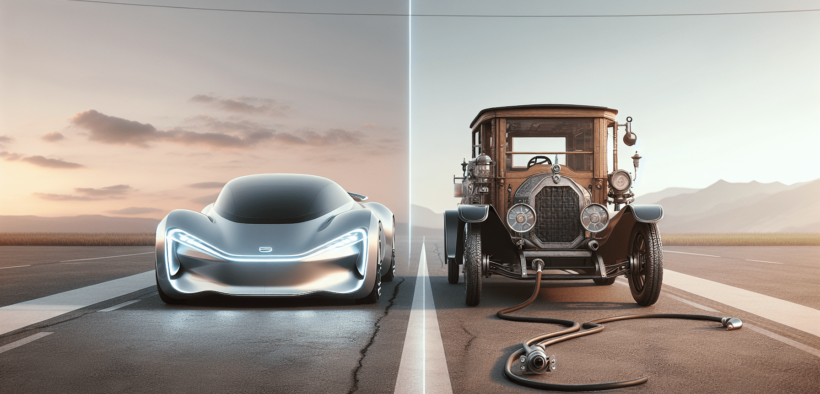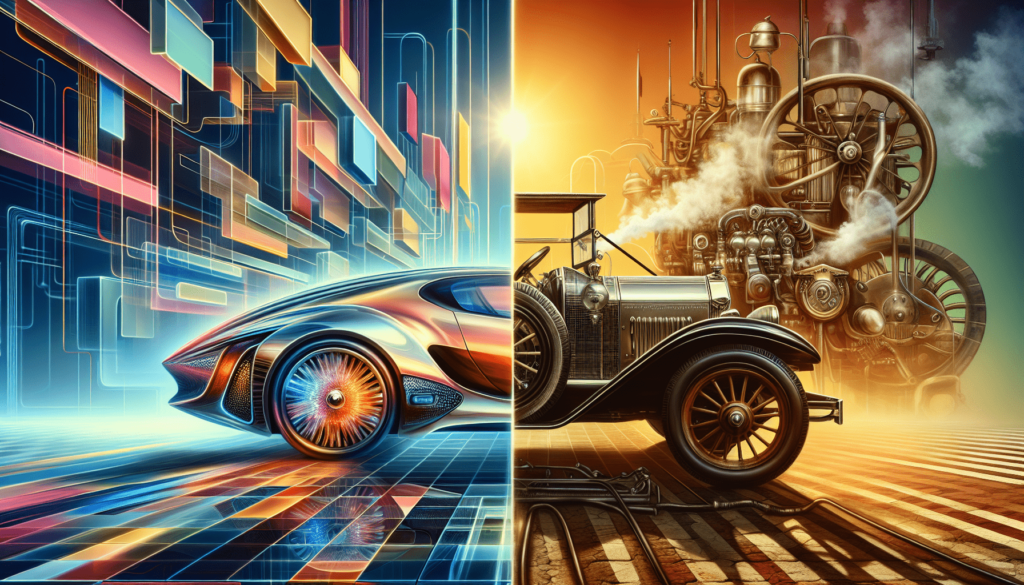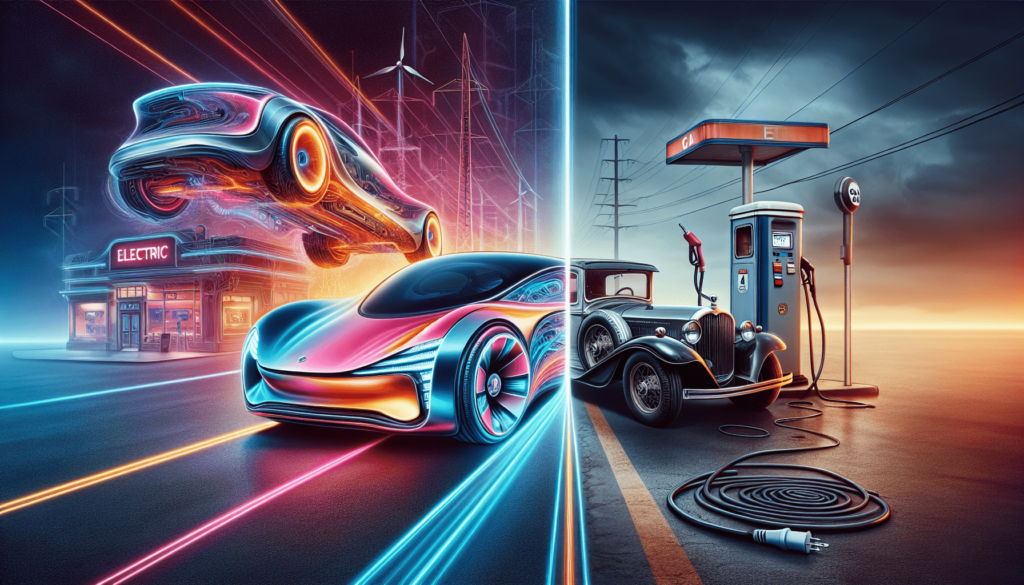The Comparison: EVs vs. Traditional Gas-Powered Cars
Share

When it comes to choosing between electric vehicles (EVs) and traditional gas-powered cars, you might find yourself wondering how they stack up against each other. Well, let’s break it down for you. EVs, powered solely by electricity, are known for their eco-friendly nature and lower operating costs. On the other hand, traditional gas-powered cars have been the go-to option for decades, offering easy access to fuel stations and a longer driving range. So, in this comparison, we’ll explore the key factors that differentiate these two options, helping you make an informed decision when it’s time to hit the road.
Environmental Impact
Reduced greenhouse gas emissions
Electric vehicles (EVs) are widely regarded as being more environmentally friendly than traditional gas-powered cars. One of the main reasons for this is that EVs produce significantly lower greenhouse gas emissions. Unlike gasoline-powered vehicles, which emit carbon dioxide and other harmful pollutants directly from the tailpipe, EVs produce zero tailpipe emissions. This means that as long as the electricity used to charge the EV comes from renewable sources, such as solar or wind power, the emissions associated with driving an EV are effectively zero.
Decreased air pollution
In addition to reduced greenhouse gas emissions, EVs also help to decrease air pollution. Gasoline-powered cars emit various pollutants, including nitrogen oxides, particulate matter, and volatile organic compounds. These pollutants contribute to poor air quality, leading to respiratory problems and other health issues. EVs help mitigate these problems by producing zero tailpipe emissions. By transitioning to EVs, we can reduce air pollution and create cleaner and healthier environments for everyone.
Less noise pollution
Another significant advantage of EVs is their ability to reduce noise pollution. Gasoline-powered vehicles are notorious for their loud engines and the noise they generate while driving. On the other hand, EVs operate much more quietly. The electric motors in EVs produce significantly less noise, leading to a quieter and more pleasant driving experience. This reduction in noise pollution not only benefits the occupants of the vehicle but also has a positive impact on the surrounding environment, making cities and neighborhoods more peaceful.
Cost and Maintenance
Lower fuel costs
One of the most appealing aspects of EV ownership is the potential for lower fuel costs. As electricity is generally cheaper than gasoline or diesel, recharging an EV can be significantly more cost-effective compared to refueling a traditional gas-powered car. The exact savings vary depending on electricity rates and fuel prices, but overall, EV owners can experience substantial savings in their day-to-day fuel expenses. This benefit becomes even more pronounced when driving longer distances, as the cost per mile for EVs tends to be lower compared to gasoline-powered vehicles.
Potential savings on maintenance
EVs also have the advantage of potentially lower maintenance costs. Unlike internal combustion engines found in traditional cars, electric motors have fewer moving parts and require less frequent maintenance. For instance, EVs do not require oil changes, and components like the exhaust system, spark plugs, and timing belts are nonexistent in an electric drivetrain. Consequently, EV owners can save on regular engine maintenance expenses. However, it’s important to note that EVs still require routine maintenance, such as tire rotations, brake inspections, and battery checks. Nonetheless, the overall maintenance costs for EVs tend to be lower compared to traditional cars.
Higher upfront cost for EVs
While EVs offer long-term savings in fuel and maintenance costs, it’s essential to consider the higher upfront cost associated with purchasing an electric vehicle. EVs often have a higher sticker price compared to their gas-powered counterparts. This price disparity can make it more challenging for some individuals to afford an EV initially. However, it’s worth noting that government incentives, tax credits, and rebates are often available to help offset the higher cost. Additionally, as EV technology advances and becomes more widespread, economies of scale may lead to more affordable options in the future.
Performance
Instant torque and acceleration
EVs are known for their impressive performance characteristics, particularly when it comes to acceleration. Electric motors deliver instant torque, providing quick and seamless acceleration from a standstill. This instant power delivery can make EVs feel remarkably responsive and zippy, delivering a surge of energy that can be exhilarating for drivers. The ability to accelerate quickly from a stop can also enhance safety on the road, making it easier to merge into traffic or avoid potential accidents.
Silky-smooth operation
Beyond their rapid acceleration, EVs also offer a smooth and quiet driving experience. Electric motors operate much more silently compared to traditional combustion engines, eliminating the rumbling and vibration typically associated with internal combustion vehicles. As a result, EVs provide a serene and peaceful ride, allowing passengers to better enjoy their journey without the constant noise and vibrations that can come from a gas-powered car. The smooth operation of EVs adds to their overall appeal and makes for a more comfortable driving experience.
Range anxiety and charging time
One of the common concerns expressed about EVs is the issue of range anxiety, which refers to the fear of running out of battery charge before reaching a destination or a charging station. EVs typically have a limited range compared to traditional cars, requiring more frequent charging. However, advancements in battery technology have led to improvements in EV range, with some models offering ranges comparable to or exceeding those of gas-powered vehicles. Additionally, the development of a robust charging infrastructure is addressing the issue of charging accessibility and reducing charging times. With more charging stations becoming available and faster charging technologies emerging, range anxiety is gradually becoming less of a barrier for EV owners.
Energy Efficiency
Higher energy conversion efficiency
One of the key advantages of EVs over traditional cars is their higher energy conversion efficiency. In gasoline-powered vehicles, only a fraction of the energy stored in gasoline is converted into useful work, with the rest being lost as waste heat. On the other hand, EVs convert a much higher percentage of the energy from the electricity they consume into the rotation of the wheels. This higher efficiency means that EVs require less energy input to achieve the same level of performance as traditional cars, resulting in reduced energy consumption and environmental impact.
Regenerative braking
Another energy-saving feature of EVs is regenerative braking. When an EV slows down or decelerates, the electric motor can function as a generator, converting some of the kinetic energy of the vehicle back into electrical energy. This energy is then stored in the vehicle’s battery pack for later use. Traditional cars, on the other hand, rely solely on mechanical braking systems, which dissipate the kinetic energy as heat. By recapturing and reusing this energy, EVs extend their range and further improve their overall energy efficiency.
Energy losses in gasoline engines
In contrast to EVs, gasoline engines suffer from significant energy losses. These losses occur due to inefficient combustion processes and energy dissipation as waste heat through the exhaust system. As a result, a considerable portion of the energy stored in gasoline is wasted, resulting in reduced efficiency and increased fuel consumption. EVs, with their higher energy conversion efficiency and lack of tailpipe emissions, provide a more sustainable and energy-efficient alternative to traditional gas-powered cars.

Driving Experience
Quiet and serene ride
The driving experience of an EV is noticeably different from that of a traditional car, primarily due to the absence of engine noise. EVs operate quietly, and this lack of sound creates a calm and serene environment within the vehicle. Without the constant rumbling and revving of an internal combustion engine, occupants can enjoy a peaceful atmosphere while driving or conversing with passengers. The reduction in noise pollution also extends to the external environment, making EVs a welcome addition to urban areas where noise levels can be a concern.
Smooth handling and responsiveness
EVs offer smooth handling and responsiveness, thanks to their design and instant torque delivery. Electric motors provide power to the wheels more directly and efficiently compared to the complex mechanical systems of traditional cars. This direct power transfer results in improved handling and maneuverability, making EVs feel more responsive and nimble on the road. The lower center of gravity, due to the positioning of the heavy battery pack, also contributes to better stability and cornering capabilities, enhancing the overall driving experience.
Lack of gear shifting
One of the noticeable differences between EVs and traditional cars is the lack of gear shifting in electric vehicles. Gasoline-powered vehicles typically have multiple gears that need to be shifted manually or automatically to optimize engine performance at different speeds. In contrast, EVs have a single-speed transmission or no transmission at all, as electric motors operate across a wide range of speeds without the need for gears. The absence of gear shifting in EVs provides a smoother and more continuous power delivery, eliminating the need to constantly change gears and resulting in a simplified driving experience.
Infrastructure
Charging station availability
The availability of charging stations is a critical aspect of the EV ownership experience. For EVs to be a viable transportation option, a network of charging stations needs to be in place. Initially, charging infrastructure may be limited in some areas, particularly in rural or less densely populated regions. However, as the adoption of EVs continues to grow, more charging stations are being installed in various locations, including public parking lots, shopping centers, and highways. Efforts are underway to expand charging infrastructure and ensure that adequate charging facilities are available to support the increasing number of EVs on the road.
Development of charging networks
The development of charging networks further contributes to the convenience and usability of EVs. Companies and organizations are establishing partnerships to create interoperable charging networks that allow EV owners to charge their vehicles seamlessly across different charging stations. This means that EV drivers can travel longer distances without worrying about access to charging infrastructure. Investment in fast-charging technologies is also improving charging speeds, making it possible to recharge an EV quickly, similar to refueling a traditional car with gasoline.
Gasoline stations and convenience
While the charging infrastructure for EVs is expanding, it is essential to acknowledge the existing convenience of traditional gasoline stations. Gasoline stations are widespread and accessible, offering a quick and straightforward refueling experience for traditional car owners. EV owners, on the other hand, may need to plan their routes carefully and ensure the availability of charging stations along their journey. Although home charging options are becoming more common, it can still be challenging for EV owners without access to dedicated charging stations, especially for those living in apartments or urban areas with limited charging infrastructure.
Range
Longer range for traditional cars
One advantage that traditional gas-powered cars have over EVs is their longer range. Gasoline-powered vehicles can travel significantly farther on a single tank of fuel compared to most EVs on a full charge. This increased range is particularly beneficial for long-distance travel, road trips, or when access to charging stations is limited. Traditional cars, with their well-established refueling infrastructure, provide greater flexibility and convenience when it comes to covering long distances without frequent stops to recharge or refuel.
Improvements in EV range
While EVs may have a range disadvantage compared to traditional cars, advancements in battery technology have significantly improved the range of electric vehicles. Modern EVs can now achieve hundreds of miles on a single charge, with some high-end models offering ranges comparable to or exceeding those of many gasoline-powered vehicles. This extended range, coupled with the expanding charging infrastructure and faster charging options, is making EVs increasingly suitable for everyday commuting and extended travel.
Implications for long-distance travel
The limited range of EVs still presents some challenges when it comes to long-distance travel. While shorter commutes and local driving are thoroughly supported by EVs, planning long trips can require more consideration. EV owners need to map out their routes to include charging stations along the way and factor in additional charging time during their journey. However, as technology advances and the charging infrastructure continues to grow, the inconvenience associated with long-distance travel in EVs is gradually diminishing. The ability to charge more quickly and with greater convenience is making EVs a more practical option for extended journeys.
Flexibility and Convenience
Easy refueling for conventional cars
One undeniable advantage of conventional cars is the ease and convenience of refueling. Gasoline stations are ubiquitous, and refueling a traditional car is a quick and straightforward process. With just a stop at the gas station, drivers can refuel their vehicles and continue their journeys without extensive planning or consideration of charging times. This convenience has been ingrained in the driving culture for decades, making gasoline-powered cars the default choice for many consumers who prioritize flexibility and ease of use.
Home charging options for EVs
While refueling at home may not provide the same level of convenience as stopping at a gasoline station, it offers a unique benefit for EV owners: the ability to charge their vehicles overnight or when parked at home. For those who have access to home charging options, this means waking up to a fully charged EV each morning, ready for the day’s travel. Home charging provides EV owners with a convenient and hassle-free method of ensuring they have sufficient battery capacity for their daily driving needs. As more public charging infrastructure is deployed, the convenience of home charging is complemented by the ability to top up while away from home.
Dependence on charging infrastructure
While home charging options exist for EV owners, those without access to dedicated charging stations must rely heavily on public charging infrastructure. This dependence on charging infrastructure can be a significant consideration for prospective EV buyers, particularly for individuals living in apartments or urban areas with limited charging availability. The accessibility and reliability of charging stations become critical factors in the decision to go electric. However, as mentioned earlier, the development and expansion of charging networks are addressing these concerns and making EV ownership increasingly viable for a wider range of individuals.

Technology and Innovation
Advancements in EV technology
EV technology has come a long way since the introduction of the first mass-produced electric vehicles. Continued advancements in battery technology have significantly improved the range, performance, and charging capabilities of EVs. Battery costs have also been steadily declining, making EVs more affordable for consumers. Moreover, innovations in regenerative braking, lightweight materials, and aerodynamics are further enhancing the efficiency and performance of electric vehicles. With ongoing research and development, EVs are poised to continue evolving and becoming even more competitive with their traditional counterparts.
Rapid evolution of traditional cars
While EVs are progressing rapidly, traditional cars are also undergoing significant advancements. Gasoline-powered vehicles are benefiting from innovations such as improved fuel efficiency, hybrid technologies, and advancements in internal combustion engine design. Manufacturers are continually striving to develop more fuel-efficient vehicles and reduce emissions. Additionally, traditional cars benefit from a vast network of support and infrastructure, making their technology more established and accessible to a wide range of consumers. The rapid evolution of traditional cars poses healthy competition to the EV industry, leading to innovation and further driving improvements in both types of vehicles.
Electric vs. hybrid vehicles
The choice between electric vehicles and hybrid vehicles is another consideration for consumers. While both types of vehicles offer environmental advantages compared to traditional gasoline-powered cars, they have different characteristics and applications. EVs, as mentioned earlier, produce zero tailpipe emissions and offer longer-range capabilities with advances in battery technology. On the other hand, hybrid vehicles combine an internal combustion engine with an electric motor, offering increased fuel efficiency and reduced emissions compared to conventional cars. The decision between electric and hybrid ultimately depends on individual preferences, driving habits, and the availability of charging infrastructure.
Government Incentives and Policies
Financial incentives for EV purchases
To encourage the adoption of EVs, many governments around the world offer various financial incentives and subsidies for EV purchases. These incentives can come in the form of tax credits, rebates, grants, or reduced registration fees. By reducing the upfront cost of purchasing an EV, governments aim to make electric vehicles more affordable and appealing to consumers. Financial incentives can significantly offset the higher sticker price of EVs, making them a more economically viable option for potential buyers. As governments continue to prioritize sustainability and reduce greenhouse gas emissions, it is likely that such incentives will continue to be offered.
Emission regulations and standards
High emissions from traditional gasoline-powered cars have led governments to implement increasingly stringent emission regulations and standards. These regulations aim to reduce the carbon footprint of transportation and improve air quality. By setting emission limits for new vehicles and enforcing stricter regulations, governments create an incentive for automakers to develop cleaner, more fuel-efficient vehicles. Such regulations have played a key role in driving the innovation and development of EV technology. As emission standards continue to tighten, EVs are expected to become an even more attractive option for both manufacturers and consumers.
Impacts on market adoption
Government incentives and policies have a significant impact on the market adoption of EVs. Financial incentives and subsidies influence consumer behavior by making EVs more price-competitive with traditional cars. By reducing the barrier to entry, governments can accelerate the transition towards electric mobility. Stringent emission regulations also create a market demand for more sustainable vehicles, pushing automakers to invest in EV technology and expand their electric vehicle offerings. As governments continue to prioritize sustainability and implement supportive policies, the market adoption of EVs is expected to grow, fostering a more sustainable transportation system.




